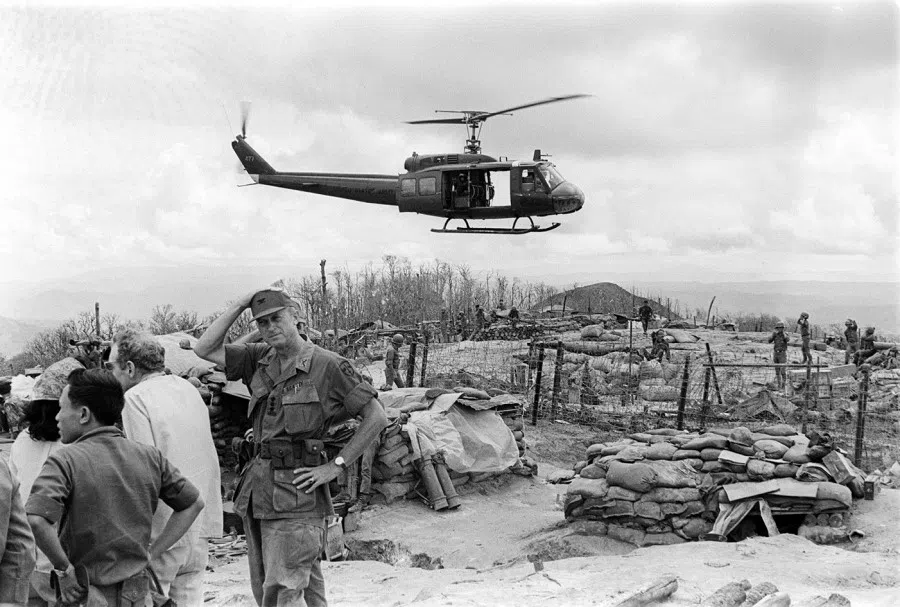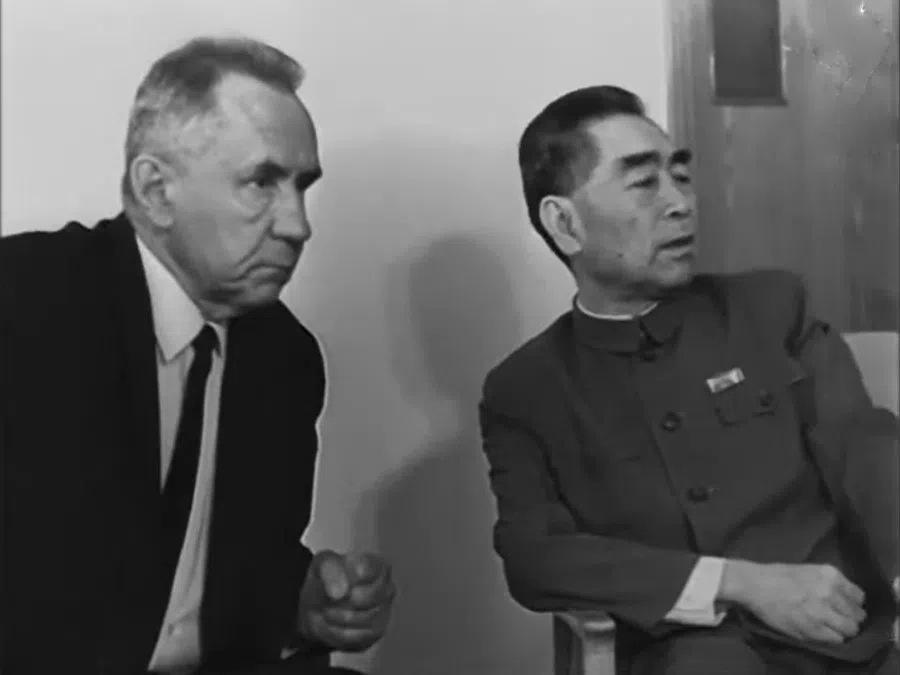What US and China can learn from the Sino-Soviet Cold War
The most common analogy for the US-China rivalry is the Cold War between the US and the Soviet Union, but Malaysian academic Ngeow Chow Bing thinks that the Sino-Soviet rivalry in the 1960s could also offer a lesson or two for the US and China, especially in staying ideologically flexible and maintaining communication between competing nations.

Several historical analogies have often been raised as the US and China entered into an intense and sustained great rivalry since the late 2010s. Analogies are not perfect, but when appropriately applied, they serve as useful references where lessons could be drawn.
Popular analogies
The most common analogy for the US-China rivalry is the Cold War between the US and the Soviet Union. Some scholars have criticised the use of this analogy, arguing that the kind of challenges presented to the US by China are vastly different from those posted by the Soviet Union, and terms such as "New Cold War" or "Cold War 2.0" therefore are misleading. Nonetheless, it is still a popular analogy.
Not only the Cold War was temporally the closest to the present era and therefore freshest in memory, its very nature exactly conveyed the kind of intense and epic geopolitical struggle between two great superpowers.
Another popular analogy is the British-German rivalry before World War I. As German power emerged and challenged the established and dominant British position, both powers inadvertently entered into a course of structurally-determined intense rivalry that ultimately, and unfortunately, had to be settled by a destructive war. On the trade front of the US-China rivalry, many also find precedents in the US-Japan trade war in the 1980s.
Sino-Soviet rivalry
There is one particular great power rivalry that has not been referenced, however, and that is the Sino-Soviet split, or the cold war in the communist world.
Termed by scholar Jeremy Friedman as the Shadow Cold War, the Sino-Soviet rivalry was the secondary front of the US-Soviet Cold War, but was a decisive factor in many ways in shaping the development and outcome of the Cold War. Kissinger-Nixon's opening to China in the early 1970s would not have been possible without the Sino-Soviet rivalry.

China and the Soviet Union were close allies in the wake of the Korean War. The Soviet Union provided massive economic and military aid to the newly born People's Republic, and was instrumental in the development of China's heavy and defence industries in the entire 1950s.
But the alliance barely survived the first decade, and increasingly turned into a bitter rivalry, driven by growing ideological differences, competition for leadership within the communist world, foreign policy differences, and the personal animosities between Mao Zedong and Nikita Khrushchev (and his successors).
In 1960, the Soviet Union recalled all its technical and scientific specialists and experts in China, a damaging move for the poorer China embarking on ambitious industrial development and modernisation. By the late 1960s, the two major communist powers saw each other as archrivals, sometimes even more so than the capitalist US.
Both China and the Soviet Union were also not competing for a different world order, but for the "correct" ideological interpretation and leadership within the communist world.
The long Sino-Soviet border with large sections not yet demarcated precipitated a number of border incidents in the entire 1960s. Finally, in March 1969, both powers fought two brief battles on the Zhenbao Island/Damasky Island on the Ussuri River. In August, the Soviet Union launched a punishment ambush against China's border troops at Tielieketi in Xinjiang. The Soviet Union also contemplated a surgical strike against China's incipient nuclear facilities. The two nuclear-armed powers seemingly were on the brink of a major war.
China was so afraid that war would break out that in October of that year, almost all of its central leaders were dispatched to areas far removed from the border should Beijing come under attack (Mao went to Wuhan). Soldiers were ordered to be battle-ready, urban residents practised air raid and evacuation drills, and important factories were relocated. China was preparing for war.
The war didn't come, but another two decades of the Sino-Soviet Cold War continued until 1989. The Sino-Soviet war scare in 1969 turned the global Cold War onto a different trajectory. China resumed its ambassadorial talk with the US in early 1970, and thus began the process leading to US-China rapprochement.
The 'correct' ideological interpretation
In a way, the Sino-Soviet rivalry was a rather strange one. Unlike most other great power rivalries, the usual structural dynamic involving a rising power and an established power was either absent as a factor, or at most only a secondary factor. Both China and the Soviet Union were also not competing for a different world order, but for the "correct" ideological interpretation and leadership within the communist world. In this rivalry, China often was the far more militant and ideologically rigid party. It accused the Soviet Union of "revisionism," selling out the cause of anti-imperialism, and eventually degenerating into a "social imperialist" power.
China's ideological militancy ultimately came at a great cost to itself. It pushed neutral countries, both within and outside of the communist camp, towards its rival.

Outside of the communist camp, neutral countries such as Egypt and India (which were also involved in bitter border disputes with China) eventually preferred the Soviet Union as a more reasonable partner. Within the communist camp, China's attitude of "you are either with me or against me" was even more damaging to its own interest.
Vietnam, reliant on both the Soviet Union and China during the Vietnam War, attempted to reconcile the two powers, but eventually was so alienated by China's ideological rigidity that it became allied with the Soviet Union against China. Vietnam saw China as the less sincere partner in its struggle during the Vietnam War, since China viewed assistance to Vietnam first and foremost as a front of its rivalry with the Soviet Union. There was a strong belief in Vietnam that China did not really genuinely care about Vietnam's national interests.
The more one of the parties in a rivalry becomes ideologically inflexible, and the more it tries to push neutral countries to "choose sides", the more it tends to alienate those neutral countries, pushing them to the rival side.
Problem of inflexibility
This could serve as an important lesson for both the US and China in their present rivalry. The more one of the parties in a rivalry becomes ideologically inflexible, and the more it tries to push neutral countries to "choose sides", the more it tends to alienate those neutral countries, pushing them to the rival side.
A pertinent lesson could also be drawn from the war scare episode in 1969. Similar to the current impasse in dialogues and communication between the US and China, especially in regard to "military-to-military communication", China and the Soviet Union were barely on talking terms.
After the March 1969 battles on Zhenbao Island, Soviet Premier Alexei Kosygin tried to reach out to the Chinese leadership via a phone call to the Chinese Ministry of Foreign Affairs, but was rebuffed by the telephone operator. Other attempts to reach the Chinese leadership also failed. Communication finally happened in early September. The death of Vietnamese leader Ho Chi Minh provided the opportunity to have a breakthrough. Returning from the funeral in Vietnam, Kosygin used the stopover in Beijing to finally have a chance to meet face-to-face with Premier Zhou Enlai and hold formal talks.
In the period between March and September, border troops of China and the Soviet Union fought each other, there was no communication, and hawkish talks of war were prevalent in both countries, matched by actual war preparation on both sides. The September Kosygin-Zhou meeting stabilised the tense relationship, although both sides actually continued to prepare for war, just in case it did happen.
Nonetheless, talks of war by top political and military leaders created their own momentum and fed the "worst-case scenario" perception for both sides, further straining an already tense atmosphere.

Mao was not reserved in openly hyping up the possibility of war during this period of time, despite his private reservation about whether the war would actually materialise. In the eyes of his Soviet adversaries, talks of war by Mao were interpreted seriously, and some Soviet generals and leaders also, in turn, talked about "teaching China a lesson".
As historian Yang Kuisong pointed out in his book Amity and Enmity between Mao Zedong and Moscow, ultimately both sides had no real intention to actually fight a war with each other, despite all the war posturing and hawkish talks. Nonetheless, talks of war by top political and military leaders created their own momentum and fed the "worst-case scenario" perception for both sides, further straining an already tense atmosphere. Had the Kosygin-Zhou meeting not taken place, would war actually break out between China and the Soviet Union? We would never know, but given the tense situation, it was perhaps a high probability.
Lesson for today
US-China rivalry today is nowhere near the Sino-Soviet war scare in 1969, but both sides should take note of how talks of war could dangerously feed into the exact tendency towards an outcome that neither side actually intended. Communication is indeed crucial, especially during the most critically tense period.
The final lesson of the Sino-Soviet Cold War was perhaps how irrational in hindsight it actually was. There were certainly many differences between both sides, but in retrospect, these were hardly irreconcilable or causes of a great rivalry. Sino-Soviet Cold War at times was even more bitter than the US-Soviet Cold War, which was more professionally managed, and less infused with distracting emotions. Personal animosities, emotional feelings of national superiority (or inferiority), paranoia, and irrationality permeated decades of the Sino-Soviet Cold War, unnecessarily fuelling an already irrational rivalry.
The structural and other core differences between the US and China today are perhaps more irreconcilable compared with those between China and the Soviet Union, but both sides should derive a lesson not to overly exaggerate those differences. They should also maintain composure and make an effort to communicate more, understand one another, and look for areas of agreement.





